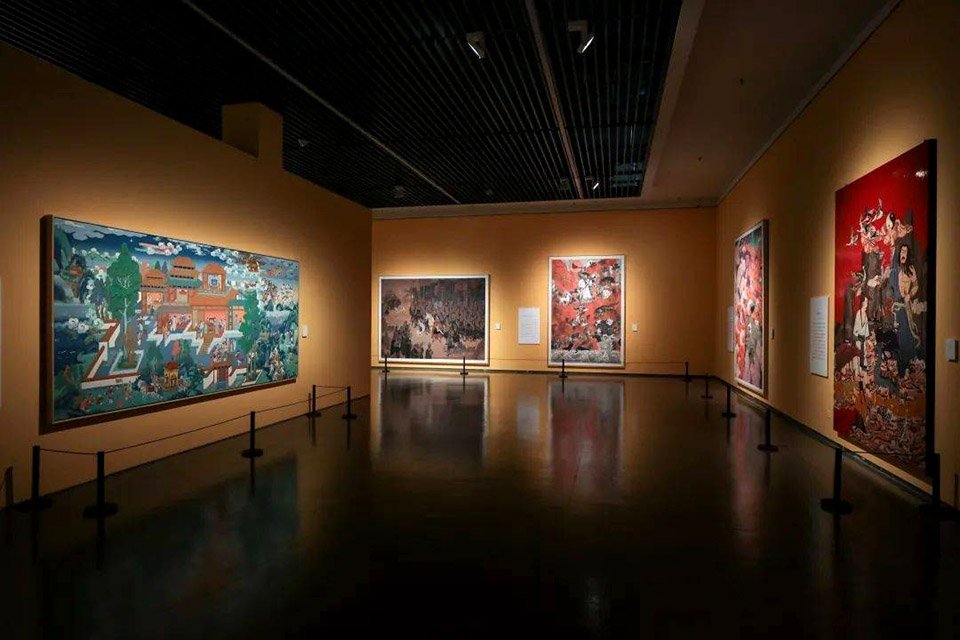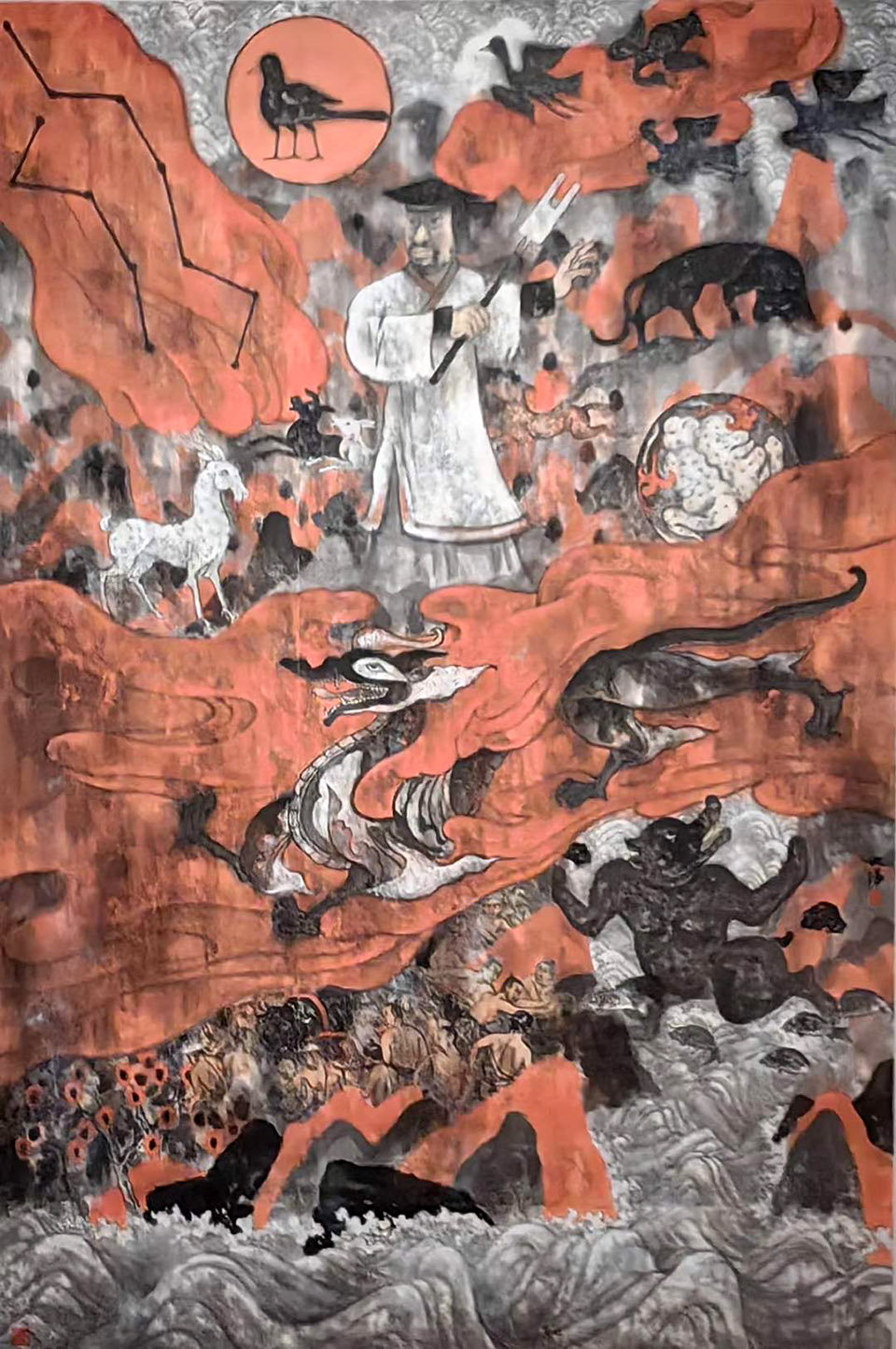By OGP Reporters / Members Contribute File Photos
Oh Good Party
Classical Chinese mythology, as a cultural resource and source of inspiration, holds significant importance for the development and inheritance of art. It enriches the subject matter and forms of artistic expression, while also deepening the connotations and cultural values of artworks. By intertwining with mythology, artistic creations not only showcase the charm and wisdom of ancient Chinese culture but also convey humanity's contemplation and exploration of life, nature, the universe, and human nature.
By visiting the exhibition 'The Creation of Heaven and Earth: Chinese Mythology in Literary and Artistic Creation and Cultural Communication Project,' we are able to witness the entire process from the chaotic cosmos to the mythical era and the birth of the embryonic form of the Chinese nation. This exhibition showcases the rich imagination and tremendous creativity of Chinese creation myths, presenting the audience with a grand and magnificent, epic-like panorama filled with twists and turns. Through the depiction of mythical stories, the exhibition explains the origins of all things in the world, as well as the indomitable and resilient spirit of the Chinese nation.
Chinese classical mythology, as a treasure of Chinese culture, is deeply rooted in the beliefs of the Chinese people and has had a profound influence on Chinese art. For thousands of years, mythical stories have been widely spread in literature, drama, folklore, as well as expressed splendidly in art forms such as painting, jade artifacts, bronze ware, and architecture.
For example, collectors of ancient jade artifacts have a special fondness for the jade pig-dragon from the Hongshan Culture (approximately 5,000 to 6,000 years ago), as it reflects the ancient people's worship of animals and reverence for natural forces, symbolizing prayers for a bountiful harvest and protection. Bronze tripods, on the other hand, represent power and governance, playing important roles in religious, sacrificial, political, and social activities, symbolizing the majesty of rulers and the stability of social order. The 'Simuwu Ding,' regarded as the pinnacle of Chinese bronze ware, is hailed as one of the most complete and earliest cast bronze vessels. Similar bronze tripods are protected by Chinese law as precious cultural relics and artworks, prohibiting their export and trade.
Traditional Chinese mythological stories such as 'Pangu Creating the World,' 'Nüwa Creating Humans,' 'Cangjie Inventing Writing,' 'The Battle of Zhuolu,' and 'Ding Establishing Order' not only provide inspiration and source material for artists but also carry profound cultural significance and philosophical reflections in artistic works. The world of Chinese classical mythology is filled with legends of gods and spirits, mythical creatures, and stories of sages and heroes. It represents the thoughts and beliefs of the Chinese nation and serves as a source of inspiration for artistic creation.
Spanning seven years, the exhibition primarily features traditional painting forms such as traditional Chinese painting, meticulous painting, and oil painting, vividly depicting the characters, landscapes, and plots from mythology through delicate lines and vibrant colors. These artworks not only express the artists' understanding and interpretation of mythological stories but also contemplate ancient Chinese culture, history, and values. In addition, other art forms such as calligraphy, sculpture, and seal carving are also included. Artists explore the relationships between humans and nature, humans and the universe, as well as important topics like human nature, morality, and wisdom by depicting the divine beings and heroic figures in mythological stories.
The exhibition represents only a small part of the storytelling of mythological tales, as classical Chinese mythology is widely applied in various aspects of life beyond painting. Examples include patterns on ceramic vessels, traditional motifs in clothing, items for festive occasions and commemorative events, as well as local ritual performances such as shamanic dances and ceremonies. In the 2012 Sotheby's Autumn Auction in Hong Kong, a Qing Dynasty blue and white "Dragon and Clouds" dish with fencai overglaze fetched a price of HKD 40.98 million. The dish depicted a five-clawed dragon in fencai red, pursuing a pearl amidst cobalt-blue waves. Mythical creatures like dragons and phoenixes are frequently used as decorations and motifs, symbolizing their esteemed status, authority, and connection with the divine.
The connection between classical Chinese mythology and art is not only reflected in specific artworks but also integrated into the creative concepts and aesthetic perspectives of artists. Characters and storylines from myths are often employed as vehicles for artists to express personal emotions and ideas. Through creative interpretation and reinterpretation, artists bestow new meanings and modes of expression upon mythological tales, fostering dialogue and resonance with contemporary society and individual experiences.
The oil painters Qiu Ruimin and Li Gen collaborated on the creation of 'Cangjie Creating Characters.' According to legend, Cangjie had four eyes and, in the form of birds and animals, painted on a sand tray, thus creating pictographic characters. The artwork is large in size, with mythical creatures surrounding Cangjie. When standing in front of the painting, viewers can sense the ancient aura and appreciate how the artists depict their understanding of the legend using contemporary artistic strokes.
Classical Chinese mythology, as a cultural resource and source of inspiration, holds significant importance for the development and inheritance of art. It enriches the subject matter and forms of artistic expression, while also deepening the connotations and cultural values of artworks. By intertwining with mythology, artistic creations not only showcase the charm and wisdom of ancient Chinese culture but also convey humanity's contemplation and exploration of life, nature, the universe, and human nature. Mythology and art mutually influence and nurture each other, providing artists with abundant creative materials and intellectual inspiration. Through the presentation of artworks, mythological stories can be perpetually passed down and bring forth the allure of art and cultural experiences to viewers. The fusion of classical Chinese mythology and art not only showcases the unique charm of Chinese culture but also enriches the diversity and depth of world art.
























Comments